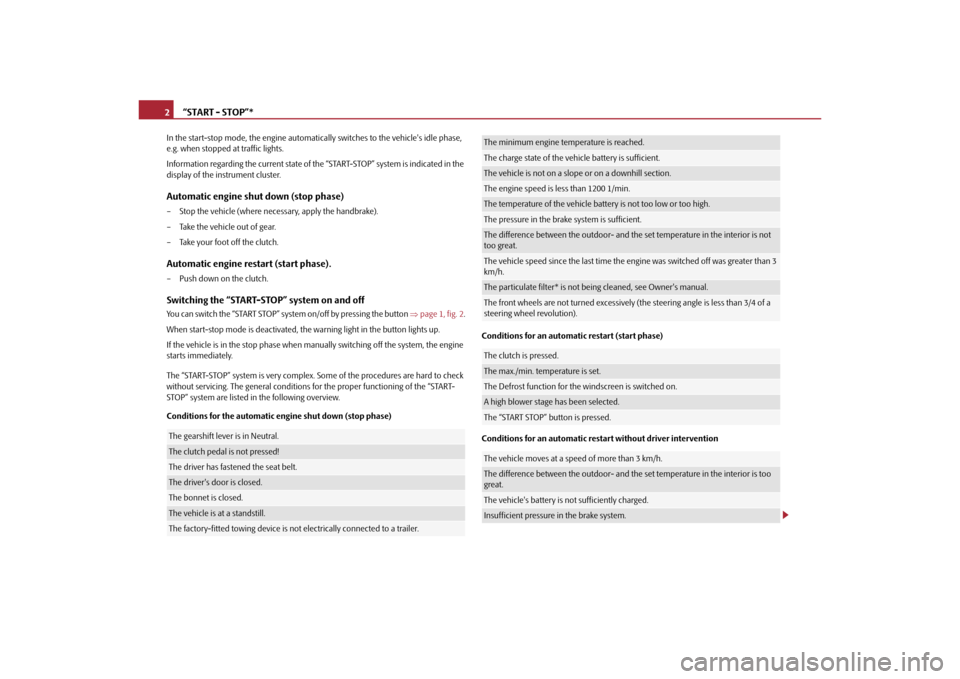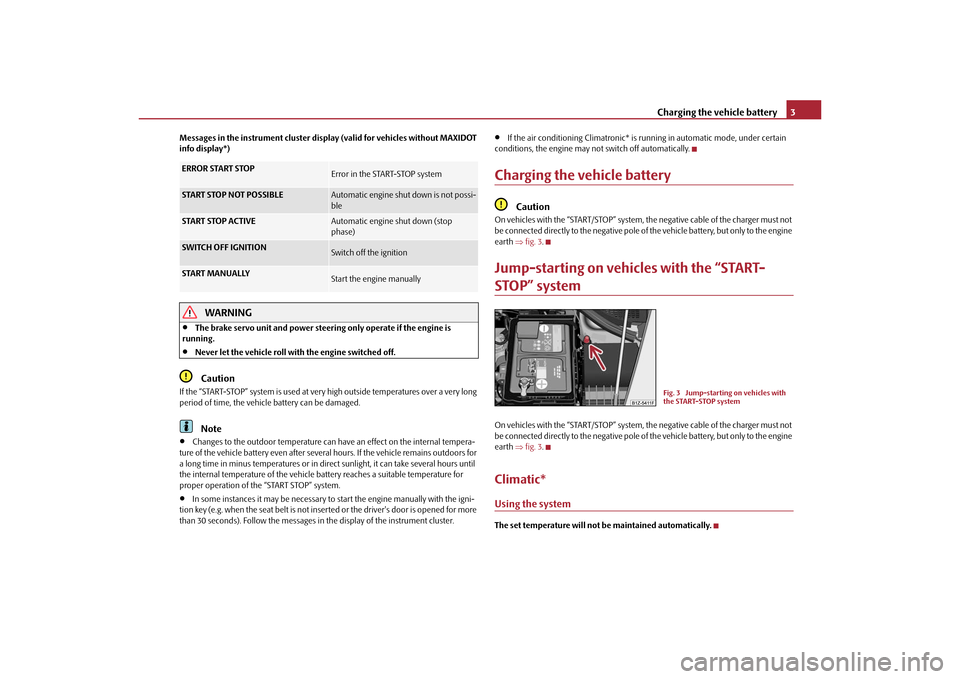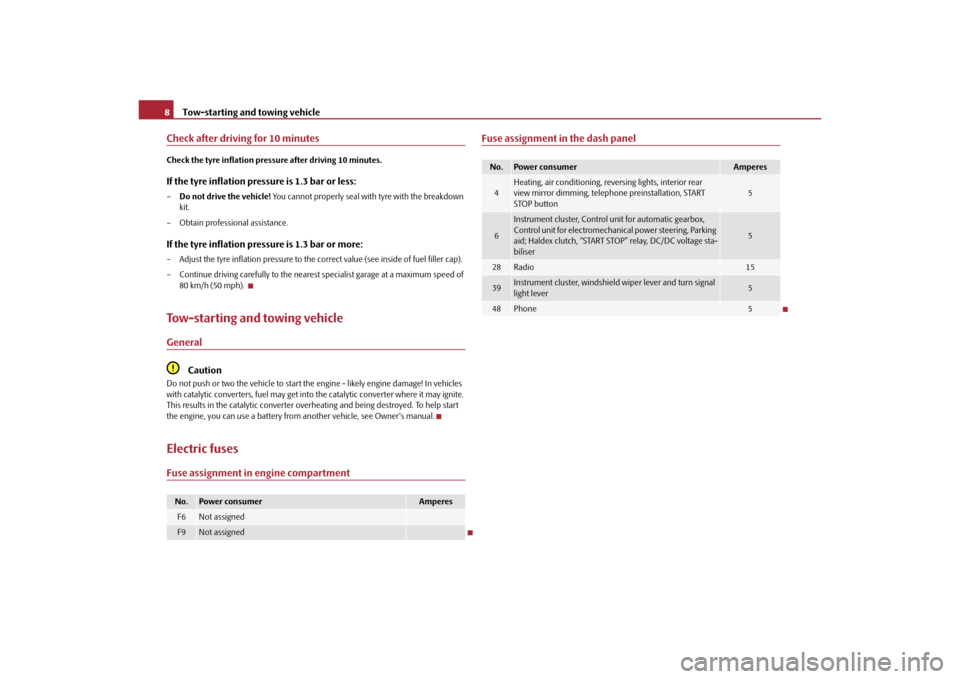battery SKODA OCTAVIA 2010 2.G / (1Z) Technical Change
[x] Cancel search | Manufacturer: SKODA, Model Year: 2010, Model line: OCTAVIA, Model: SKODA OCTAVIA 2010 2.G / (1Z)Pages: 22, PDF Size: 0.95 MB
Page 3 of 22

“START - STOP”*
2
In the start-stop mode, the engine automatica lly switches to the vehicle's idle phase,
e.g. when stopped at traffic lights.
Information regarding the current state of th e “START-STOP” system is indicated in the
display of the instrument cluster.Automatic engine shut down (stop phase)– Stop the vehicle (where nece ssary, apply the handbrake).
– Take the vehicle out of gear.
– Take your foot off the clutch.Automatic engine restart (start phase).– Push down on the clutch.Switching the “START-STOP” system on and offYou can switch the “START STOP” system on/off by pressing the button page 1, fig. 2 .
When start-stop mode is deactivated, the warning light in the button lights up.
If the vehicle is in the stop phase when ma nually switching off the system, the engine
starts immediately.
The “START-STOP” system is very complex. Some of the procedures are hard to check
without servicing. The general conditions for the proper functioning of the “START-
STOP” system are listed in the following overview.
Conditions for the automatic engine shut down (stop phase) Conditions for an automatic restart (start phase)
Conditions for an automatic restart without driver interventionThe gearshift lever is in Neutral.The clutch pedal is not pressed!The driver has fastened the seat belt.The driver's door is closed.The bonnet is closed.The vehicle is at
a standstill.The factory-fitted towing device is no t electrically connected to a trailer.
The minimum engine temperature is reached.The charge state of the vehicle battery is sufficient.The vehicle is not on a slope or on a downhill section.The engine speed is less than 1200 1/min.The temperature of the vehicle battery is not too low or too high.The pressure in the brake system is sufficient.The difference between the outdoor- and the set temperature in the interior is not
too great.The vehicle speed since the last time the engine was switched off was greater than 3
km/h.The particulate filter* is not be ing cleaned, see Owner's manual.The front wheels are not turned excessively (t he steering angle is less than 3/4 of a
steering wheel revolution).The clutch is pressed.The max./min. temperature is set.The Defrost function for the windscreen is switched on.A high blower stage has been selected.The “START STOP” button is pressed.The vehicle moves at a speed of more than 3 km/h.The difference between the outdoor- and the set temperature in the interior is too
great.The vehicle's battery is not sufficiently charged.Insufficient pressure in the brake system.
s1ec.5.book Page 2 Friday, September 24, 2010 10:46 AM
Page 4 of 22

Charging the vehicle battery3
Messages in the instrument cluster display (valid for vehicles without MAXIDOT
info display*)
WARNING
•
The brake servo unit and power steerin g only operate if the engine is
running.
•
Never let the vehicle roll wi th the engine switched off.Caution
If the “START-STOP” system is used at very high outside temperatures over a very long
period of time, the vehicle battery can be damaged.
Note
•
Changes to the outdoor temperature can ha ve an effect on the internal tempera-
ture of the vehicle battery even after severa l hours. If the vehicle remains outdoors for
a long time in minus temperatures or in dire ct sunlight, it can take several hours until
the internal temperature of the vehicle battery reaches a suitable temperature for
proper operation of the “START STOP” system.
•
In some instances it may be necessary to start the engine manually with the igni-
tion key (e.g. when the seat belt is not inserted or the driver's door is opened for more
than 30 seconds). Follow the messages in the display of the instrument cluster.
•
If the air conditioning Climatronic* is running in automatic mode, under certain
conditions, the engine may no t switch off automatically.
Charging the vehicle battery
Caution
On vehicles with the “START/STOP” system, the negative cable of the charger must not
be connected directly to the negative pole of the vehicle battery, but only to the engine
earth fig. 3 .Jump-starting on vehicles with the “START-STOP” systemOn vehicles with the “START/STOP” system, the negative cable of the charger must not
be connected directly to the negative pole of the vehicle battery, but only to the engine
earth fig. 3 .Climatic*Using the systemThe set temperature will not be maintained automatically.
ERROR START STOP
Error in the START-STOP system
START STOP NOT POSSIBLE
Automatic engine shut down is not possi-
ble
START STOP ACTIVE
Automatic engine shut down (stop
phase)
SWITCH OFF IGNITION
Switch off the ignition
START MANUALLY
Start the engine manually
Fig. 3 Jump-starting on vehicles with
the START-STOP system
s1ec.5.book Page 3 Friday, September 24, 2010 10:46 AM
Page 9 of 22

Tow-starting and towing vehicle
8
Check after driving for 10 minutesCheck the tyre inflation pressu re after driving 10 minutes.If the tyre inflation pressure is 1.3 bar or less:–Do not drive the vehicle! You cannot properly seal wi th tyre with the breakdown
kit.
– Obtain professional assistance.If the tyre inflation pressure is 1.3 bar or more:– Adjust the tyre inflation pressure to the correct value (see inside of fuel filler cap).
– Continue driving carefully to the nearest specialist garage at a maximum speed of 80 km/h (50 mph). Tow-starting and towing vehicleGeneral
Caution
Do not push or two the vehicle to start the engine - likely engine damage! In vehicles
with catalytic converters, fuel may get into the catalytic converter where it may ignite.
This results in the catalytic converter overheating and being destroyed. To help start
the engine, you can use a battery from another vehicle, see Owner's manual.Electric fusesFuse assignment in engine compartment
Fuse assignment in the dash panel
No.
Power consumer
Amperes
F6
Not assigned
F9
Not assigned
No.
Power consumer
Amperes
4
Heating, air conditioning, reversing lights, interior rear
view mirror dimming, telephone preinstallation, START
STOP button
5
6
Instrument cluster, Control unit for automatic gearbox,
Control unit for electromechani cal power steering, Parking
aid; Haldex clutch, “START ST OP” relay, DC/DC voltage sta-
biliser
5
28
Radio
15
39
Instrument cluster, windshield wiper lever and turn signal
light lever
5
48
Phone
5
s1ec.5.book Page 8 Friday, September 24, 2010 10:46 AM